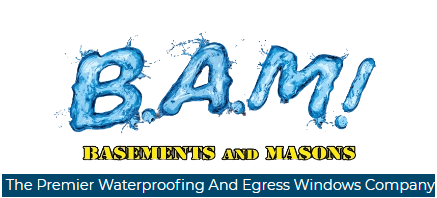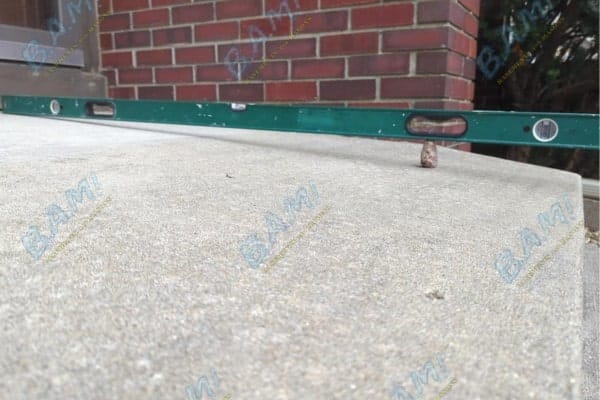When it comes to any type of repair, most people want to know if the fix is going to last or are they going to have to repeat the process again in a short amount of time. Making sure a repair job is effective and long-lasting is one of the first things you want to investigate when considering a solution. This applies to concrete lifting, too. Why would you waste the time and money to lift your concrete if it is just going to sink again? That’s why our Polylifting process is designed to last.
The lifting solution should last just as long as the concrete surface. The trick is to not only lift the sunken concrete, but to remedy the cause of the sinking.
What’s going on under the concrete with Polylifting?
BAM Basements and Masons can inject polyurethane foam under your concrete slab using this injection gun in a process also known as polylifting.
You can patch a crack or lift a concrete slab a thousand times, but if you don’t take care of the cause of the problem, you’re just going to keep repeating yourself, while throwing money out the window. Most of the time, the soil underneath the slab is either weak or missing. The polyurethane foam that we inject under the slab expands, filling the void, compressing the weak soil, and sealing the bottom of the slab against water and moisture.
By keeping the soil stable and strong, the concrete won’t move or sink. It takes an expert to find the right locations to inject the polyurethane foam, in addition to the right amount. If the holes aren’t placed in the correct location, the polyfoam won’t fill in the correct spots under the slab and the polylifting won’t be as effective.
There are several reasons why the soil under a slab can fail. If it wasn’t properly compressed during construction, it will settle from the weight of the slab and traffic above it. If there is a drainage problem, the soil can erode or wash away, leaving a void underneath the slab. Earth is strong, but if it is weakened or absent, it won’t be able to do the job. The polyurethane foam can compress the soil, making it supportive of the slab. The foam can also expand, filling in the empty space where the soil is left. Once the foam hardens, it is stronger than the soil and water resistant, so it won’t wash away while also holding up the concrete slab.
Preventative Maintenance
There are a few things you can do around your property to help keep your concrete slab stable and undamaged. These solutions are relatively easy and inexpensive (especially when compared to repairing or replacing a concrete slab).
Clean out your Gutters!
Check that your downspouts are draining at least 5 feet away from the slab. This seems to be the most common problem. People are pretty good at making sure that the drains empty away from their foundations, but they don’t think about sidewalks, driveways, and patios. Keep your gutters in good condition. If the gutters are clogged or damaged, the water running off the roof isn’t going to drain properly. Replacing gutters can be a hassle, but it will protect your home or business, along with the surrounding property.
If there isn’t backfill around the edge of the concrete slabs, you may want to add it. This will keep the water draining away from the slab, in addition to preventing animals from burrowing underneath the concrete.
Reapply caulk or other sealants to the joint between concrete slabs. This will prevent water from entering from above in addition to protecting any rebar that may be connecting the two slabs.
If you help protect your concrete, polylifting will last longer, providing you with years of concrete support.
Polyjacking vs Mudjacking
Mudjacking used to be the best method to use should you need your concrete slab lifted because it has sunk. The best new method for concrete slab lifting is polyjacking. Polyjacking generally follows a similar technique to mudjacking, so there isn’t much of a learning curve. However, the materials and steps involved in polyjacking are different. This proves to be a much more effective way of lifting the slab while being less invasive as well. We will be discussing the reasons why polyjacking is a better solution for Concrete Raising and why this is.
1. Difference in Material
In mudjacking, a material which is composed of mud which is then mixed with cement. This is a messy slurry that gets a lot of things dirty should we not be careful. However, whenever we use the polyjacking method, we use a polyurethane material which is less invasive for the soil and takes less to achieve the same effect that mudjacking does.
2. Minimally Invasive
The act of concrete slab lifting itself is invasive. No matter what, we will have to drill a hole, or holes into the concrete slab for there to be a way for us to lift it up. However, we can control how invasive it is. When using the mudjacking method, there must be 1-inch drill hole or multiple of these and a lot of mud-cement mix to lift the concrete slab up. However, when using the polyjacking method, we only drill a small hole which is around 5/8th inch large, or several depending on the slab size. Using Polyurethane to raise the slab is less invasive as well. We can use a lot less polyurethane to achieve the same effect that would require a lot of the mud mixture.
3. Better for the soil
Mud mixture has proved to be very poor when considering the soil and tends to overburden it easily, which can mean that the slab will probably sink again at some point due to all the added weight. When using Polyurethane, we can provide the same raising effect we are looking for, whilst using a lot less of it. This allows for less disruption in the soil, which in turn has less chance of proving detrimental to things around the concrete itself, such as plants.
4. Poly is faster
There is a much longer curing time for the mud mixture. There is often a wait time of up to three days, which is far too long to wait considering the slab should not be used for that length of time at all to ensure proper settling in. Polyurethane, on the other hand, can reach its max rigidity in around an hour. This proves the job much easier for you because it will have less impact on your daily routine.
How PolyJacking works
Polyjacking is a term used for a method of concrete lifting that involves the use of a poly-foam compound. In this method of concrete lifting an expanding poly-foam compound is injected underneath your sunken concrete slabs at key points to raise it to its proper level and to also provide a deterioration resistant support material underneath the slab. The process is simple and can be completed in under a day depending on the size of the concrete slab that needs to be repaired.
What Poly can be used to Lift?
Because the expanding foam used for the polyjacking method is so strong it can be used to lift any number of concrete slabs. Look below to see what applications polyjacking is appropriate for.
Patios
Driveways
Garage Floors
Basement Floors
Walkways
Warehouse Floors
Parking Lots
Pool Decks
The Polyjacking Process
The process of polyjacking is both simple and effective. When we arrive at the jobsite, we follow these steps to repair your sinking concrete.
1. Cleaning
Our technicians will clean the surface to prevent dust and debris from preventing the proper repair.
2. Prep
Once the surface is clean our technicians will identify, mark, and drill holes in the key areas needed to raise your concrete properly.
3. Pumping
Our technicians will start pumping the polyfoam into the drilled holes to start lifting the concrete. We will use levels to level the concrete out and keep going until we have achieved maximum recovery.
Choose BAM to Give Your Concrete A Lift
Contact us to learn more about lifting your damaged concrete slab and keeping your property safe and stable. We look forward to raising your concrete and giving you some peace of mind. There are so many Polylifting companies in Des Moines out there, and you might not know who to get in touch with. Make sure to do your homework, check reviews, BBB Ratings and support local small businesses. That’s why you should call BAM Basements and Masons of Des Moines. Since 2012, we’ve been raising all sorts of concrete slabs with foam, including sidewalks, patios, driveways, and more. We also offer foundation repair, basement waterproofing, crawl space repair, and more. Call us today for your free estimate.

